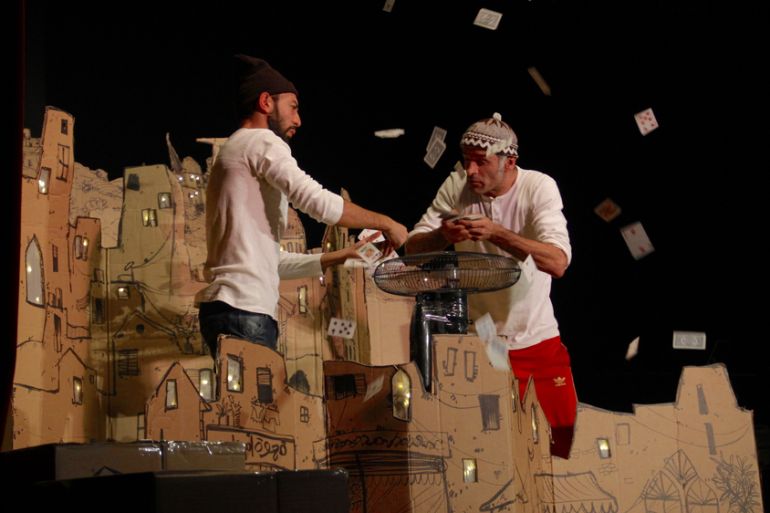Puppet show casts spotlight on refugee crisis
Palestinian artist Mahmoud Hourani’s silent play aims to discover why refugees are risking everything to reach Europe.

As Europe faces its most urgent refugee crisis since World War II, Mahmoud Hourani’s silent play, One Thousand and One Titanics, is travelling the world in an attempt to explore why so many refugees have gambled on such a hazardous journey.
A hybrid between puppetry and modern performance, One Thousand and One Titanics tells the story of Ahmad, a young Arab boy who escapes falling bombs in an unnamed country and hops aboard a rubber boat to cross the Mediterranean Sea. So far, the performance has been staged in Denmark, Sweden, Tunisia and Lebanon, and it will next have showings in the UK and Spain.
Keep reading
list of 4 itemsUN report charts lethal cost of migration over past decade
Conflict, climate, corruption drive Southeast Asia people trafficking: UN
Bodies of three Rohingya found as Indonesia ends rescue for capsized boat
Hourani, 43, started puppetry in the occupied West Bank city of Hebron when he was just 19. He later moved to the UK to study puppetry and, in 2008, he established the Arab Puppet Theatre Foundation (APTF) in Lebanon, raising awareness of humanitarian issues in the Middle East.
Al Jazeera spoke with Hourani about the inspiration for his latest work and the feedback he has received in Europe and the Middle East.
Al Jazeera: What inspired you to combine the story of the Titanic, the One Thousand and One Nights tale and the ongoing refugees crisis?
Mahmoud Hourani: Firstly, I thought about the similarities between the faith of Titanic and the refugees’ sinking dinghies. The former turned into a famous worldwide incident, while the latter is quickly becoming a story that people are no longer interested in. The Titanic was carrying European immigrants to the US, and now the rubber boats are carrying immigrants from Africa and Asia to Europe.
These flimsy objects symbolise the fragility of humankind in wartime. The paper boats we show on the stage leave no doubt about the vulnerability of the refugees' rubber boats and their hazardous experience.
In addition, I wanted to show the contrast between the reality of life in this region and the old Middle Eastern fairytales. Stories with happy endings, such as One Thousand and One Nights, are well known in the West. Finally, with this play, I wanted to flesh out the causes and the challenges that each refugee faces along the dangerous journey across the Mediterranean Sea, which unfortunately has no happy endings.
Al Jazeera: Why did you use materials such as newspaper, cardboard and plastic sheets for the stage setting?
Hourani: These are the materials you can find in any place the refugees reside. These flimsy objects symbolise the fragility of humankind in wartime. The paper boats we show on the stage leave no doubt about the vulnerability of the refugees’ rubber boats and their hazardous experience. It also demonstrates the instability of their lives.
Al Jazeera: How have European audiences reacted to the performance?
Hourani: The main reaction was questions about the place where the story occurs. The European audience asked me whether Ahmad is from Gaza, or Iraq, or Syria. My answer was that he is from none of them and from all of them. This story is not bounded by frontiers or regions. War is an ugly human act that could happen anywhere, from the Middle East to Zaire, Vietnam, or Colombia.
Al Jazeera: Why do you use puppets to communicate with adults?
Hourani: One of the goals of the APTF is to change the misconception that puppet shows are only for children. This performance technique has a long tradition in the Arab world for talking about unspeakable political and social issues. Also, our performance is not limited to puppets. For us, all the props are considered as puppets. We deploy this traditional art form to talk about the realities of our era. We are trying to reintroduce this art to people as well as adding new dimensions to this fading art form.

Apart from this play, which targets the adult audience, we perform shows for children in schools in the Palestinian camps in Lebanon. We have a different approach to puppetry in those shows and we focus on educational topics for children.
Al Jazeera: What are the topics of those performances?
Hourani: Those shows are aimed at delivering educational messages and are produced in partnership with UNICEF. We first assess the main issues faced by children in the Palestinian refugee camps and then design and perform the shows.
For instance, our latest children’s show, From Every Garden a Rose, focuses on dropping out of school, accepting newcomer refugees and violence against children. With these performances in Palestinian refugee schools in Lebanon, we are filling the gaps left by the strict teaching methods in those schools. Most of these refugee students have never seen a live show before our performances.